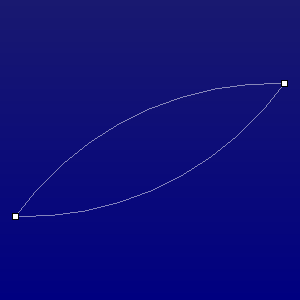SelectedVerticesAndEdges
Repository source: SelectedVerticesAndEdges
Description¶
- Thanks to Eric Monson
Other languages
See (Python), (PythonicAPI)
Question
If you have a question about this example, please use the VTK Discourse Forum
Code¶
SelectedVerticesAndEdges.cxx
#include <vtkAnnotationLink.h>
#include <vtkGraphLayoutView.h>
#include <vtkIdTypeArray.h>
#include <vtkInteractorStyleRubberBand2D.h>
#include <vtkNamedColors.h>
#include <vtkNew.h>
#include <vtkRandomGraphSource.h>
#include <vtkRenderWindow.h>
#include <vtkRenderWindowInteractor.h>
#include <vtkRenderedGraphRepresentation.h>
#include <vtkRenderer.h>
#include <vtkSelection.h>
#include <vtkSelectionNode.h>
#include <iostream>
namespace {
class RubberBandStyle : public vtkInteractorStyleRubberBand2D
{
public:
static RubberBandStyle* New();
vtkTypeMacro(RubberBandStyle, vtkInteractorStyleRubberBand2D);
virtual void OnLeftButtonUp() override
{
// Forward events
vtkInteractorStyleRubberBand2D::OnLeftButtonUp();
vtkSelection* selection = this->View->GetRepresentation()
->GetAnnotationLink()
->GetCurrentSelection();
vtkSelectionNode* vertices = nullptr;
vtkSelectionNode* edges = nullptr;
if (selection->GetNode(0)->GetFieldType() == vtkSelectionNode::VERTEX)
{
vertices = selection->GetNode(0);
}
else if (selection->GetNode(0)->GetFieldType() == vtkSelectionNode::EDGE)
{
edges = selection->GetNode(0);
}
if (selection->GetNode(1)->GetFieldType() == vtkSelectionNode::VERTEX)
{
vertices = selection->GetNode(1);
}
else if (selection->GetNode(1)->GetFieldType() == vtkSelectionNode::EDGE)
{
edges = selection->GetNode(1);
}
vtkIdTypeArray* vertexList =
dynamic_cast<vtkIdTypeArray*>(vertices->GetSelectionList());
std::cout << "There are " << vertexList->GetNumberOfTuples()
<< " vertices selected." << std::endl;
auto hasVertices = vertexList->GetNumberOfTuples() > 0;
if (hasVertices)
{
std::cout << "Vertex Ids: ";
for (vtkIdType i = 0; i < vertexList->GetNumberOfTuples(); i++)
{
if (i < vertexList->GetNumberOfTuples() - 1)
{
std::cout << vertexList->GetValue(i) << ", ";
}
else
{
std::cout << vertexList->GetValue(i) << std::endl;
}
}
}
vtkIdTypeArray* edgeList =
dynamic_cast<vtkIdTypeArray*>(edges->GetSelectionList());
std::cout << "There are " << edgeList->GetNumberOfTuples()
<< " edges selected." << std::endl;
auto hasEdges = edgeList->GetNumberOfTuples() > 0;
if (hasEdges)
{
std::cout << "Edge Ids: ";
for (vtkIdType i = 0; i < edgeList->GetNumberOfTuples(); i++)
{
if (i < edgeList->GetNumberOfTuples() - 1)
{
std::cout << edgeList->GetValue(i) << ", ";
}
else
{
std::cout << edgeList->GetValue(i) << std::endl;
}
}
}
if (hasVertices || hasEdges)
{
std::cout << "- - -" << std::endl;
}
else
{
std::cout << std::endl;
}
}
vtkGraphLayoutView* View;
};
vtkStandardNewMacro(RubberBandStyle);
} // namespace
int main(int, char*[])
{
vtkNew<vtkNamedColors> colors;
vtkNew<vtkRandomGraphSource> source;
vtkNew<vtkGraphLayoutView> view;
view->AddRepresentationFromInputConnection(source->GetOutputPort());
view->GetRenderWindow()->SetSize(600, 600);
view->GetRenderWindow()->SetWindowName("SelectedVerticesAndEdges");
view->GetRenderer()->SetBackground(
colors->GetColor3d("MidnightBlue").GetData());
view->GetRenderer()->SetBackground2(
colors->GetColor3d("RoyalBlue").GetData());
vtkNew<RubberBandStyle> style;
style->View = view;
view->SetInteractorStyle(style);
view->ResetCamera();
view->Render();
view->GetInteractor()->Start();
return EXIT_SUCCESS;
}
CMakeLists.txt¶
cmake_minimum_required(VERSION 3.12 FATAL_ERROR)
project(SelectedVerticesAndEdges)
find_package(VTK COMPONENTS
CommonColor
CommonCore
CommonDataModel
FiltersGeneral
InteractionStyle
RenderingContextOpenGL2
RenderingCore
RenderingFreeType
RenderingGL2PSOpenGL2
RenderingOpenGL2
ViewsInfovis
)
if (NOT VTK_FOUND)
message(FATAL_ERROR "SelectedVerticesAndEdges: Unable to find the VTK build folder.")
endif()
# Prevent a "command line is too long" failure in Windows.
set(CMAKE_NINJA_FORCE_RESPONSE_FILE "ON" CACHE BOOL "Force Ninja to use response files.")
add_executable(SelectedVerticesAndEdges MACOSX_BUNDLE SelectedVerticesAndEdges.cxx )
target_link_libraries(SelectedVerticesAndEdges PRIVATE ${VTK_LIBRARIES}
)
# vtk_module_autoinit is needed
vtk_module_autoinit(
TARGETS SelectedVerticesAndEdges
MODULES ${VTK_LIBRARIES}
)
Download and Build SelectedVerticesAndEdges¶
Click here to download SelectedVerticesAndEdges and its CMakeLists.txt file. Once the tarball SelectedVerticesAndEdges.tar has been downloaded and extracted,
cd SelectedVerticesAndEdges/build
If VTK is installed:
cmake ..
If VTK is not installed but compiled on your system, you will need to specify the path to your VTK build:
cmake -DVTK_DIR:PATH=/home/me/vtk_build ..
Build the project:
make
and run it:
./SelectedVerticesAndEdges
WINDOWS USERS
Be sure to add the VTK bin directory to your path. This will resolve the VTK dll's at run time.
